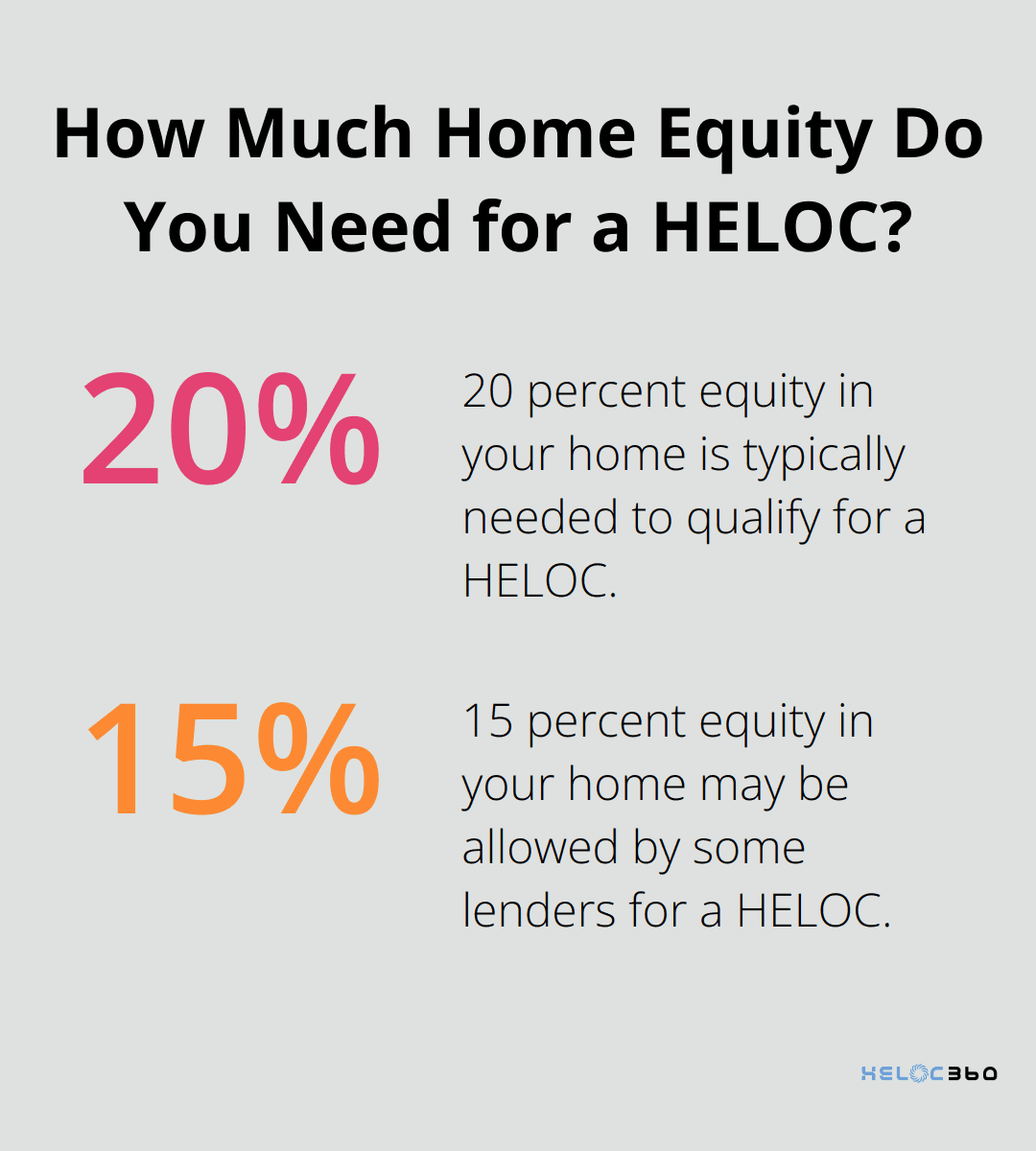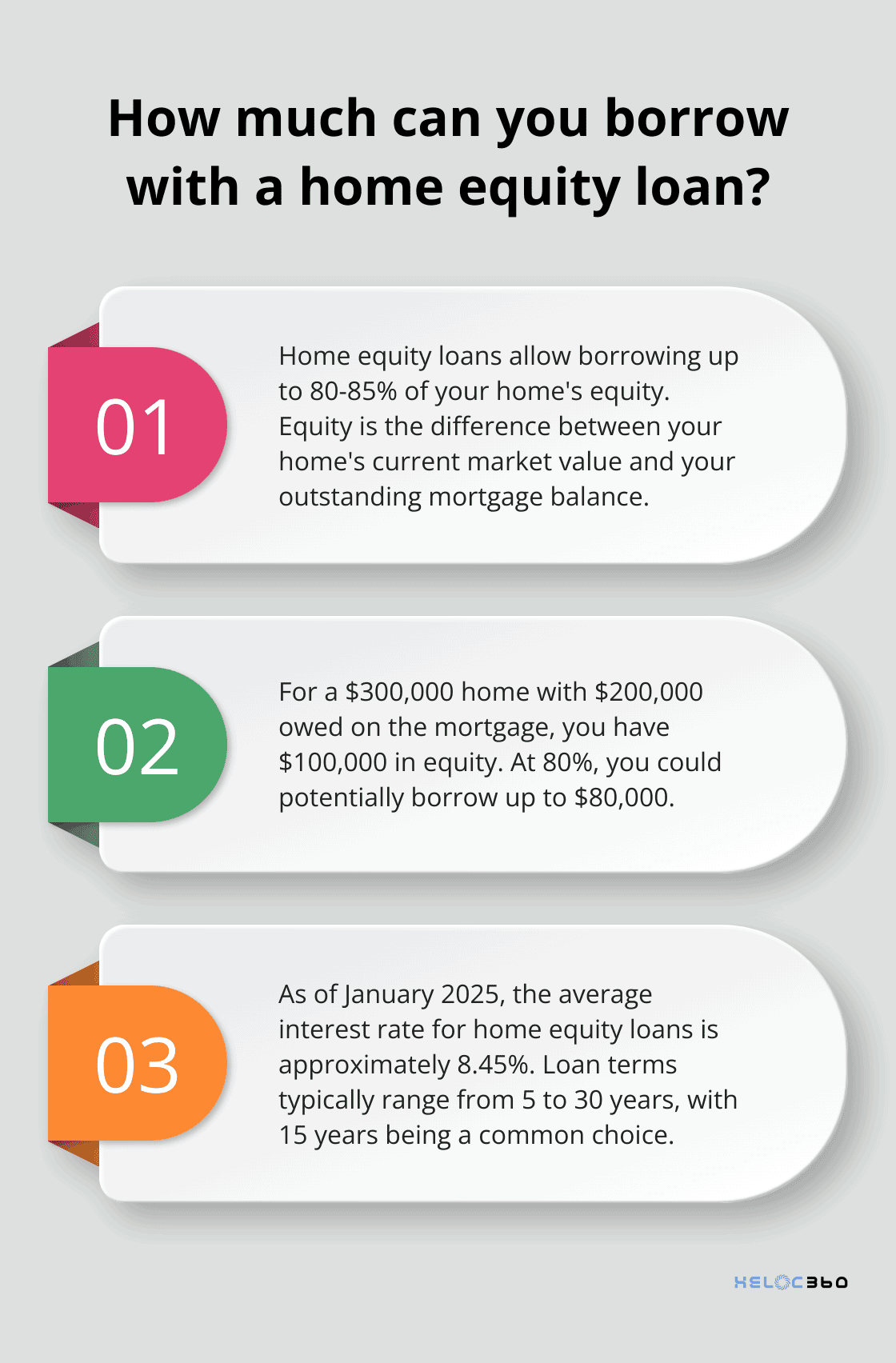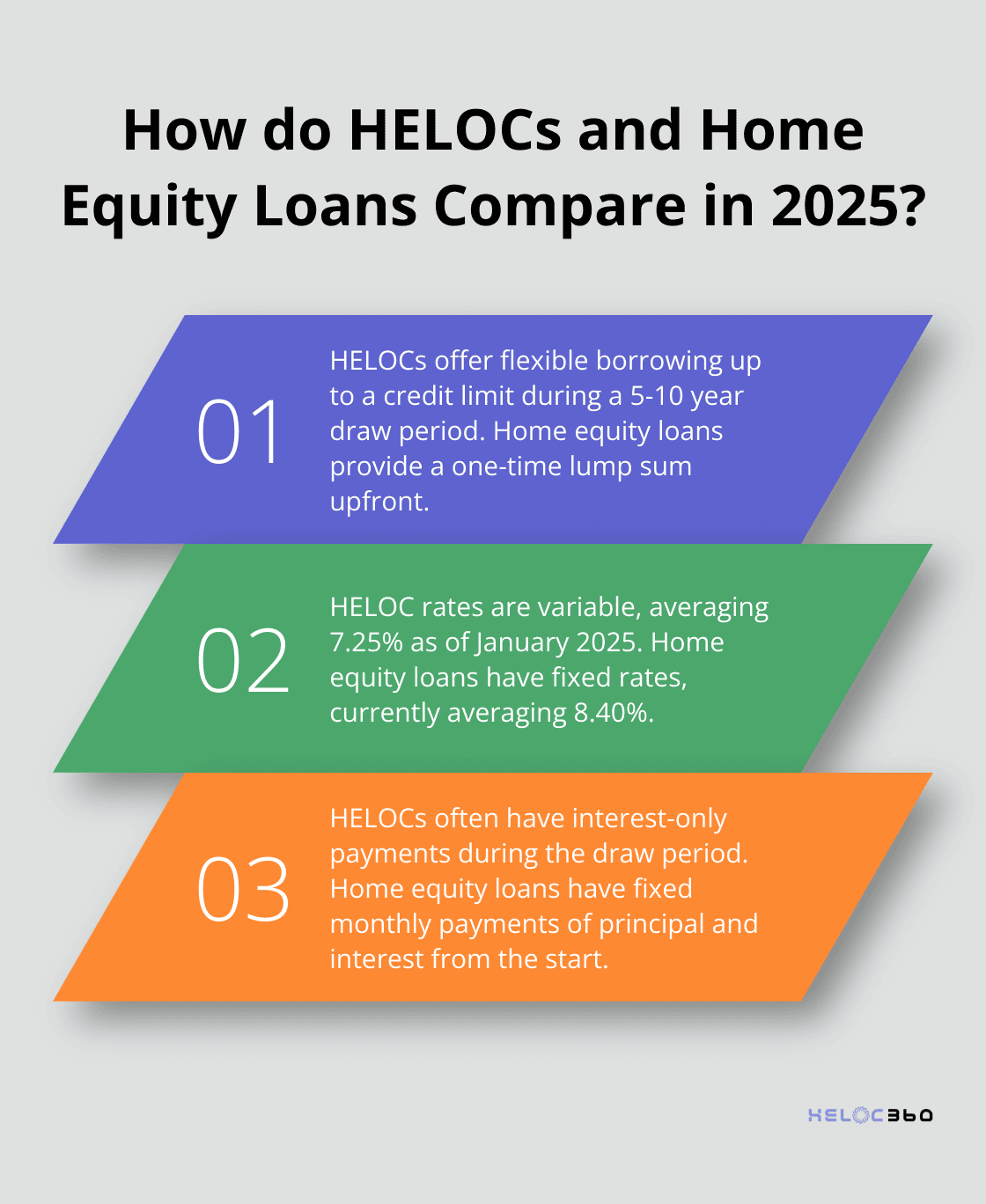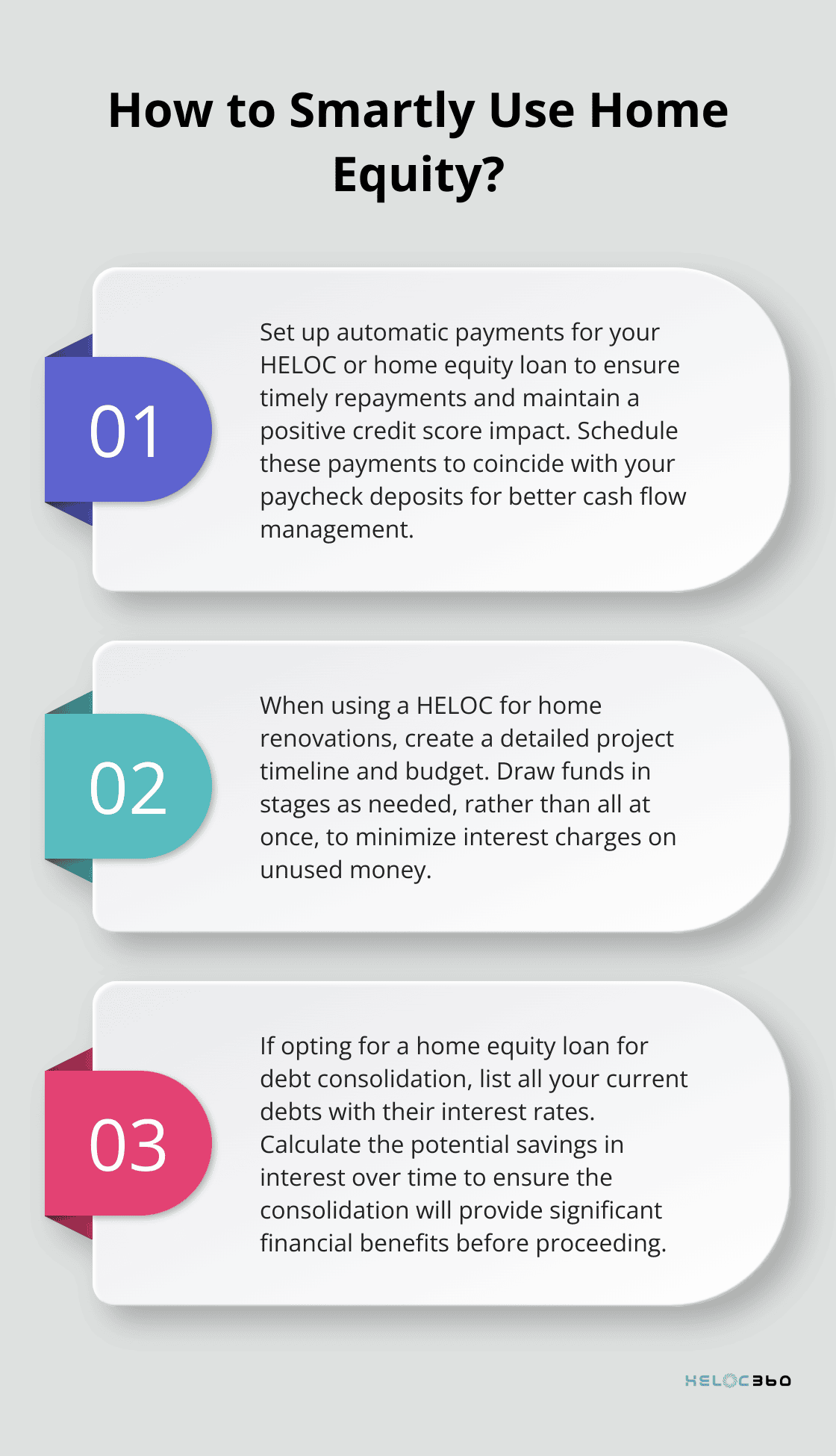Homeowners often face a crucial decision when tapping into their property’s equity: choosing between a line of credit and a home equity loan. At HELOC360, we understand the importance of making an informed choice.
The difference between a line of credit and a home equity loan can significantly impact your financial strategy. This post will break down both options, helping you determine which best suits your needs.
What Is a Home Equity Line of Credit?
Definition and Basic Concept
A Home Equity Line of Credit (HELOC) is a financial tool that allows homeowners to borrow against their property’s equity. It functions as a revolving credit line, similar to a credit card, but uses your home as collateral. To qualify for a HELOC, you’ll typically need at least 20 percent equity in your home, although some lenders may allow as low as 15 percent.
How HELOCs Work
When you open a HELOC, the lender approves you for a maximum credit limit based on your home’s value and outstanding mortgage balance. The HELOC typically has two phases:
- Draw Period: This phase lasts 5-10 years. You can borrow up to your credit limit as needed. You only pay interest on the borrowed amount, not the entire credit line.
- Repayment Phase: This phase usually lasts 10-20 years. You can no longer borrow from the line and must repay the principal plus interest.
HELOC Interest Rates and Terms
HELOCs usually come with variable interest rates, which means your payments can change over time. As of January 2025, the average HELOC rate is forecasted to be around 7.25%. However, rates can vary significantly based on factors such as your credit score and loan-to-value ratio.

Some lenders offer fixed-rate options for HELOCs, allowing you to lock in a portion of your balance at a set rate. This option can provide more predictability in your monthly payments.
Advantages of Using a HELOC
- Flexibility: You can borrow what you need when you need it, making it ideal for ongoing expenses or projects with uncertain costs. (For example, home renovations with potential unexpected expenses.)
- Lower Interest Rates: HELOCs often have lower interest rates compared to credit cards or personal loans, making them attractive for debt consolidation or major purchases.
- Potential Tax Benefits: As of 2025, the tax deductibility of interest paid on HELOCs used for home improvements may be limited. It’s important to consult with a tax professional for the most up-to-date information on your specific situation.
- Financial Safety Net: Many homeowners use HELOCs to create a financial buffer for unexpected expenses or opportunities.
HELOCs offer a powerful tool for homeowners to leverage their property’s value. However, it’s important to understand the terms and have a solid repayment plan to use this financial instrument effectively. In the next section, we’ll explore another popular option for accessing home equity: home equity loans.
What Are Home Equity Loans?
Definition and Basic Concept
Home equity loans allow homeowners to access their property’s value. These loans provide a lump sum upfront, which makes them suitable for large, one-time expenses.
How Home Equity Loans Work
A home equity loan borrows against the equity you’ve built in your home. The loan amount depends on the difference between your home’s current market value and your outstanding mortgage balance. Most lenders permit borrowing up to 80-85% of your home’s equity.

For instance, if your home is worth $300,000 and you owe $200,000 on your mortgage, you have $100,000 in equity. At 80%, you could potentially borrow up to $80,000 (this example illustrates the concept without recommending a specific course of action).
Interest Rates and Terms
Home equity loans typically feature fixed interest rates, which result in consistent monthly payments throughout the loan term. As of January 2025, the average interest rate for home equity loans stands at approximately 8.45%, according to recent market data.
Loan terms usually span from 5 to 30 years, with 15 years as a common choice. Longer terms lead to lower monthly payments but increase the total interest paid over time.
Advantages of Home Equity Loans
Fixed interest rates simplify budgeting, as you know your exact monthly payment. This predictability benefits homeowners on fixed incomes or those who prefer stable financial planning.
Homeowners often use these loans for major home improvements, which can increase property value. For example, a kitchen remodel costing $50,000 could potentially add $40,000 to your home’s value (based on industry estimates).
The potential tax deductibility of interest presents another advantage. While tax laws can change, as of 2025, interest on home equity loans used for home improvements may qualify for tax deductions. (Always consult a tax professional for the most current information.)
Many homeowners successfully use home equity loans for debt consolidation. Replacing high-interest credit card debt with a lower-interest home equity loan could save thousands in interest over time.
Important Considerations
It’s important to note that home equity loans use your home as collateral. Failure to repay could result in foreclosure. Always carefully evaluate your financial situation and repayment ability before taking out a home equity loan.
Now that we’ve explored home equity loans, let’s compare them to Home Equity Lines of Credit (HELOCs) to understand the key differences between these two popular financing options.
How Do HELOCs and Home Equity Loans Compare?
Borrowing Structure and Flexibility
HELOCs offer more flexibility than home equity loans. With a HELOC, you can borrow as needed up to your credit limit during the draw period (typically 5-10 years). This makes HELOCs ideal for ongoing expenses or projects with uncertain costs. For example, if you renovate your home and encounter unexpected expenses, you can easily access additional funds.

Home equity loans provide a lump sum upfront. This structure works well for large, one-time expenses with known costs, such as debt consolidation or major home improvements. Once you receive the funds, you can’t borrow more without applying for a new loan.
Interest Rates and Repayment Terms
HELOCs usually come with variable interest rates, which can fluctuate based on market conditions. As of January 2025, the average HELOC rate is forecast to be around 7.25%. However, this rate can change over time, potentially affecting your monthly payments.
Home equity loans typically feature fixed interest rates, currently averaging about 8.40%. While this rate is slightly higher than the average HELOC rate, it remains constant throughout the loan term, providing predictable monthly payments.
Repayment terms also differ. HELOCs often have interest-only payments during the draw period, followed by principal and interest payments during the repayment period. Home equity loans have fixed monthly payments of both principal and interest from the start.
Tax Implications and Credit Score Impact
Both HELOCs and home equity loans may offer tax benefits, but it’s important to consult a tax professional for the most up-to-date information. Some homeowners can still qualify for a tax deduction on home equity loan interest thanks to a loophole, but only if the loan money meets IRS-approved use.
Regarding credit score impact, both options can affect your credit similarly. Opening either a HELOC or home equity loan will result in a hard inquiry on your credit report, which may temporarily lower your score. However, making timely payments on either can positively impact your credit over time.
Best Use Cases
HELOCs are often best for:
- Home renovation projects with uncertain costs
- Creating a financial safety net for emergencies
- Funding ongoing expenses like education costs
Home equity loans are typically ideal for:
- Major, one-time expenses with known costs
- Debt consolidation to simplify multiple payments
- Large purchases requiring a fixed repayment schedule
The choice between a HELOC and a home equity loan depends on your specific financial situation and goals. Try to evaluate your needs carefully and consult with financial professionals to make the best decision for your circumstances.
Final Thoughts
The difference between a line of credit and a home equity loan impacts your financial strategy. A HELOC provides flexibility with variable rates for ongoing expenses, while a home equity loan offers a lump sum with fixed rates for one-time costs. Your choice depends on your borrowing needs, risk tolerance, and long-term financial plans.
HELOC360 helps homeowners navigate home equity borrowing complexities. We connect you with lenders that match your unique financial situation. Our platform provides comprehensive solutions tailored to your specific needs.

HELOC360 empowers you to unlock your home’s equity potential. We guide you through the process, whether you plan major renovations, consolidate debt, or seek financial flexibility. With our expertise, you can explore your options and make the most of your home’s value to achieve your financial goals.
Our advise is based on experience in the mortgage industry and we are dedicated to helping you achieve your goal of owning a home. We may receive compensation from partner banks when you view mortgage rates listed on our website.
